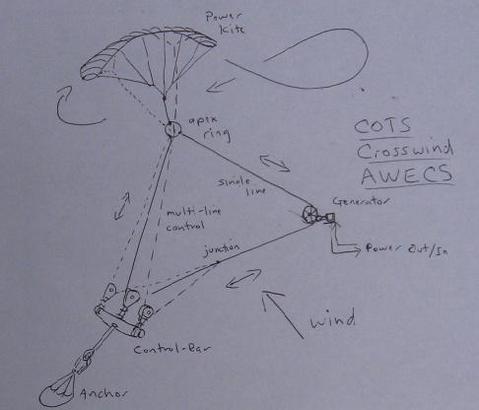|
Superior Low-tech Crosswind AWECS
Solution

Perhaps the most powerful and cheap AWECS concept is
a modern traction kite tacking back and forth crosswind on a moving
string triangle loop capstaned to a generator. The kite is at the apex
and the triangle's two legs form a string "A-frame" across the wind. The
two ground vertices are pulley-anchors. Power is extracted at a
pulley-anchor or by a capstan on the ground-leg of the string triangle.
The default kite steering solution has been a radio-control servo-pod,
but this entails higher weight, complexity, and capital-cost.
An elegant mechanical steering rig, comparable to the traction-kite
control bar and flyable by any kite-pilot, was missing until now. The
new low-tech KiteLab solution is very simple (see attached JPG) and can
be rigged from pure COTS. It took years to figure out each puzzle piece.
A final clue was the rediscovery of Pocock's kite bridle rigging.
The new solution goes like this: The apex of the string triangle is a
bridle-ring (or climber's figure-eight or rigger's plate). The ring
allows the power-kite's main-lines to remain fixed while steering-lines
pass thru the ring. The ring forces all lines to flex from a single
point, maintaining steering register between the lines as the kite works
against the anchored triangle. The kite's forelines and the two legs of
the string triangle main loop are tied off at the apex ring.
Anchored at one side of the string triangle is a conventional control
bar rigged with three pulleys. The control-bar is now a heddle-bar to
vary and mix the control input. Two steering lines ("brake" or "D"
lines) run from the kite, thru the apex ring, down thru the control bar
pulleys and terminate attached to the main loop at the center of the
crosswind leg.
The remaining anchor-pulley is where the generator may go, but a
capstaned generator can also be located at the control-bar, if desired.
This frees up the single-line/single-pulley vertex to be a traveler to
adjust the crosswind path. Vehicles would also work well.
Any quad-line kite-pilot can now generate electricity by flying the
traction-kite back and forth with the familiar control-bar. Rigging a
two line kite is even simpler. One line ties off at the apex-ring & the
other passes thru the ring down to a two-pulley bar. This bar can be
extended on the upwind side as a tiller-bar.
The rig is easily automated by using a tail-stabilized power kite (see
Pocock's) and rigging a limit-cycle. As the kite reaches the
end-of-travel it can be tacked by a flip-flop lever triggered by a
stopper-ball snubbing up at a pulley.
An outstanding quality of this rig is the capability to launch or land
the kite "at hand," right at the control-bar pilot-station. That is too
cool.
This powerful low-cost low-complexity concept is not only a great DIY
COTS AWE solution, but also promises to scale greatly. Imagine a stack
of stock Gigaflys making mega-power by this rigging method.
FairIP/CoopIP
~Dave Santos Aug
10 , 2010
M1953
Comment and development of this topic will be occurring here.
All, send notes, drawings, and photographs!
Terms and aspects:
Related links:
Commentary is welcome:
|
